Meadows of the sea
Discovering the wonders of Wakatobi’s seagrass beds
Wakatobi’s House Reef has earned a reputation as one of the world’s finest shore dives. This expansive coral garden, which lies just a short swim from the beach, stretches for more than three miles and offers untold hours of diving and snorkeling adventures. But there’s another dimension to this site that should not be missed, and it lies even closer to shore. Just off the beach, stretching from the low tide line to the edge of the reef lies a swatch of greenery. This is the realm of the seagrasses, and though at first glance it may look like nothing more than a patch of uncut grass on your front lawn, or “seaweed,” it is actually a distinct and fascinating ecosystem filled with a wide range of creatures awaiting discovery.
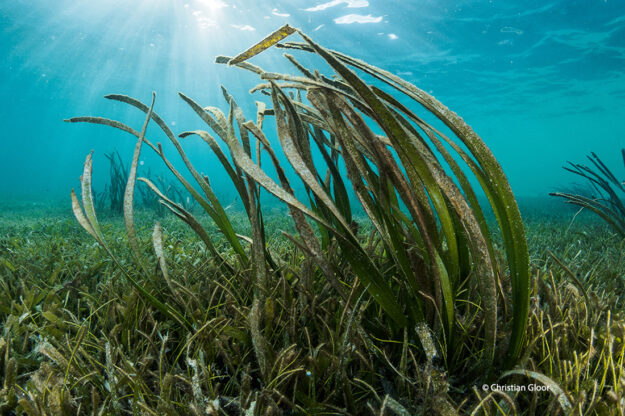
The seagrass meadows’ living leaves create a forest-like canopy that provides cover for small organisms such as juvenile fish and a range of invertebrates. The blades’ ability to go with the flow creates the mesmerizing undulations we often encounter when swimming over a seagrass meadow. Photo by Christian Gloor
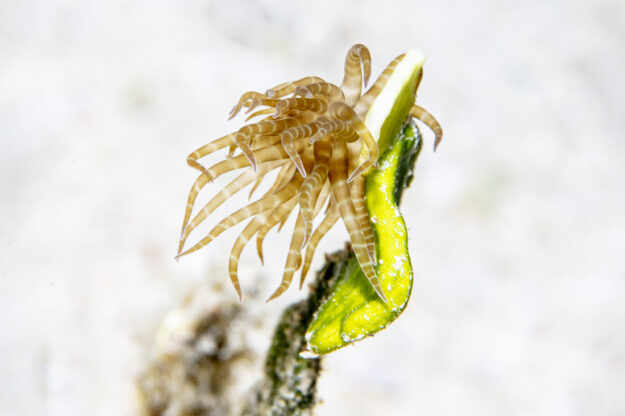
A free swimming sea anemone comes to rest on a seagrass frond on the Wakatobi House Reef. Photo by Pam Osborn
A different kind of grass
While it’s generally accepted that life came from the ocean and moved onto the land, seagrasses apparently took a U-turn at some point. Starting some 100 million years ago, grasses growing on land began to adapt to salt water and expanded into coastal shallows. Today, the 60-something species of seagrass found around the world still have more in common with their terrestrial cousins like algae and other marine vegetation. Like land grasses, they depend on sunlight to feed themselves through photosynthesis and put down roots that draw nutrients from the ground rather than the surrounding water. They are true flowering plants, releasing pollen and seeds that drift with the currents. The one feature that was lost in the migration back into the sea was the need for a thick stalk to counteract the forces of gravity, as seagrass blades are near neutral in buoyancy. The blades’ ability to go with the flow creates the mesmerizing undulations we often encounter when swimming over a seagrass meadow.
Seagrass meadows form a rich and diverse ecosystem that is every bit as important to Wakatobi’s marine environment as the area’s coastal mangrove forests and coral reefs.
Seagrasses need abundant sunlight and a sea floor soft enough to put down roots, which is why in places such as Wakatobi, you’ll find them growing only on the shallow, sedimentary flats between shore and reef. Here, they often form vast meadows that stretch from the low tide line to the hard substrate marking the beginnings of the reef, or into water depths down to 3 or 4 meters. All too often, snorkelers and divers overlook these grass beds as they fin their way out to the reef. Those in the know, however, will pay more attention to that band of grass between shore and reef, because these meadows form a rich and diverse ecosystem, every bit as important to Wakatobi’s marine ecosystem as the area’s coastal mangrove forests and coral reefs.
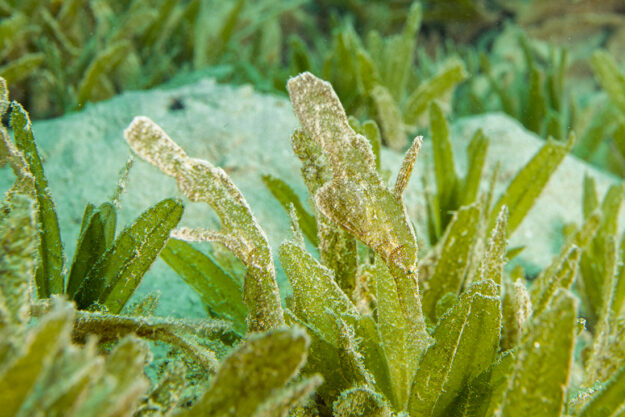
This pair of Robust ghost pipefish (Solenostomus halimeda) were found floating nearly motionless in the meadows fronting the resort. Wakatobi’s seagrass gardens are the ideal environment for this smallest of the ghost pipefish as they feed on tiny crustaceans in the grass. Photo by Richard Smith
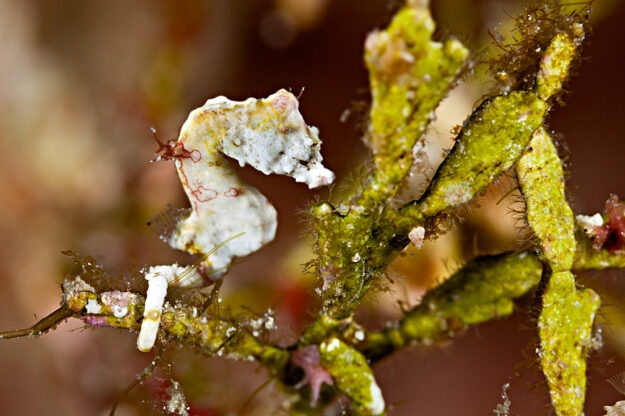
The rare Pontoh’s pygmy seahorse (Hippocampus pontohi) has been spotted on various types of seagrass, living in high-current areas. Divers and snorkelers report them on many types of seagrass and algae, moving frequently to different hitching spots. Photo by Wakatobi Resort
Nearshore nursery
A seagrass meadow is much more than just a stand of underwater weeds. These plants form the cornerstone of a rich ecosystem that provides food and shelter for a variety of aquatic flora and fauna. The seagrass meadows of Wakatobi create a diverse food web in several different ways. Animals such as green sea turtles, which are often seen in the shallows around the resort, feeding directly on the living leaves. But even when not eaten outright, seagrass leaves will benefit the ecosystem. Many of the nutrients absorbed from the sea floor are released into the water column, where they become available to small filter feeders. The seagrasses also support additional secondary plant life including numerous species of algae, bacteria, and plankton that either grow directly on the living plants or take nutrition from the dead and decaying leaves that fall to the sea floor. In addition, when living or dead seagrass blades are carried away by currents, they feed creatures in ecosystems ranging from the reef and open water to the deep sea floor.
Scientific studies have identified more than 180 species of fish that either call Wakatobi’s grass beds home or visit on a regular basis.
Living leaves also create a forest-like canopy that provides cover for small organisms such as juvenile fish and a range of invertebrates. Their presence in turn draws a range of predators. And when the grass beds are closely associated with reefs, as in the case on our House Reef, they become important nurseries for many reef-dwelling species. Scientific studies have identified more than 180 species of fish that either call Wakatobi’s grass beds home or visit on a regular basis. Add in the several thousand invertebrate animals that are likely to be found here and you have a prime hunting ground for critter spotting.
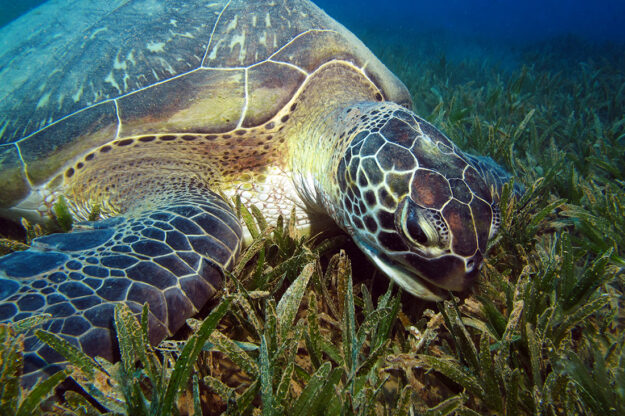
Animals such as green sea turtles are often seen in the shallows around the resort, feeding directly on the living leaves. Photo by Wakatobi Resort
High time for seagrass
The best time for a visit to Wakatobi’s seagrass beds is at or near high tide. This not only assures ample depths within the lagoon to perform fin kicks without silting or damaging the grasses, it is also the time when the majority of transient species move in from the reef. Your first spotting will probably be a green sea turtle, as generations of these aquatic reptiles hatch on the beach at Wakatobi; over the years the resort has been a sanctuary for turtles to live and breed. You’ll also see fish flitting about as well, like Silver biddys and thumbprint emperor fish, along with several varieties of colorfully-hued rabbitfish.
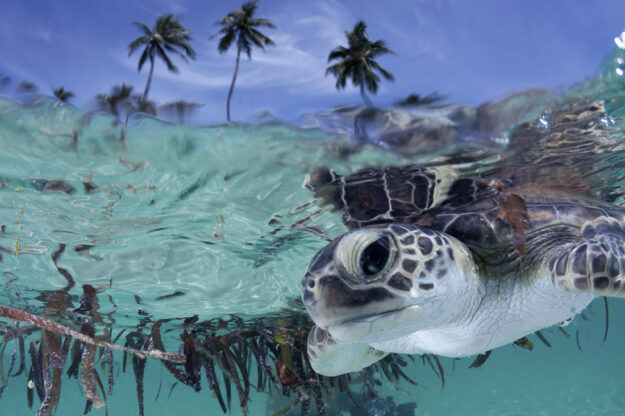
Sea turtle hatchlings often enjoy the tasty seagrasses readily available in front of the resort. Photo by Steve Miller
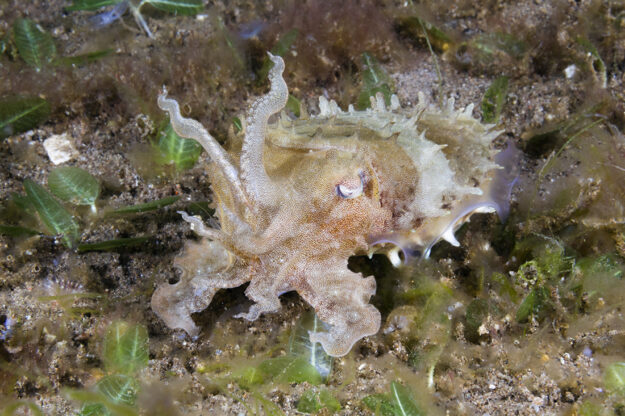
Encounters with cuttlefish roaming through the seagrass and sand bottom are likely, right in front of the resort. Photo by Walt Stearns
Though sightings are not guaranteed, there’s a better-than-average chance you’ll encounter cuttlefish or squid, either patrolling singly or in roving packs, their bodies pulsing in mesmerizing displays. Look closer among the grasses and you may sight a juvenile eel slithering among the stalks, or discover a young blue-spotted stingray hovering close to the bottom. There are octopuses lurking in the meadows as well, but it can take a keen eye to discover these masters of camouflage. Zoom in again and you’ll find a whole new level of life, with shrimp and crabs moving about. Take a closer look at what at first may seem like a random bit of debris and you could find yourself face-to-snout with a pipefish or seahorse. The list goes on, and sightings are limited only by your patience, and the amount of time you devote to exploring this transition zone between beach and reef.
The next time you visit Wakatobi, make sure to spend some time in the shallows, discovering yet another dimension to one of the world’s richest marine ecosystems.
Time for a visit? Contact us at office@wakatobi.com or Enquire >here
Visit us on Facebook | Instagram | YouTube


